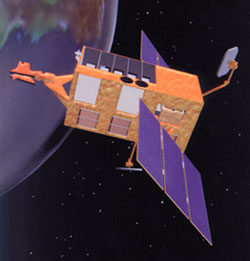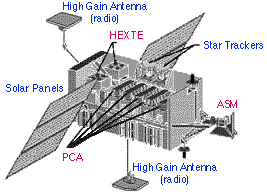RXTE Discoveries
NASA's Rossi X-ray Timing Explorer Marks 10 Years in Space - January 2006

|
Among its most important observations, NASA's Rossi X-ray Timing Explorer has shown how time creeps to a halt near a black hole event horizon. Fittingly, the passing of time appears to have slowed for the satellite itself. The mission celebrates a remarkable ten years in orbit on December 30, 2005.
Ten years in the harsh environment of space is a long time, and few satellites last this long. Yet the Rossi Explorer is still generating results that are the subject of presentations, press releases and a press conference at the American Astronomical Society meeting in January, 2006.
"The Rossi Explorer is a one-of-a-kind observatory that can clock the movement of matter, space and time around neutron stars and black holes, a premier test of Einstein's theory of general relativity," said Dr. Jean Swank, Rossi Project Scientist at NASA Goddard Space Flight Center in Greenbelt, Md. "Few of us expected this satellite to continue to produce excellent science a full decade after its launch."
Some satellites, such as NASA's Hubble and Chandra observatories, excel in producing exquisite images. Others have large light-collection areas and produce fine spectra, a graphical representation of the temperature, velocity and other characteristics of objects. The Rossi Explorer is the only observatory dedicated to "timing" observations.
The satellite's two instruments make sensitive measurements of a celestial object's variability --- that is, how it flickers --- over time scales ranging from milliseconds to years. The visible night sky appears eternal and unchanging to our eyes. If we could see only X-rays, however, ordinary stars would disappear and the sky would pulsate with the activity of objects far more energetic than our sun.
Neutron stars that are bright for months can suddenly go dormant for years without warning. Thermonuclear bursts will periodically erupt from the surface of neutron stars. Black holes will swallow gas ripped from a companion star, momentarily lighting the region. These objects flicker in the sky like fireflies.
Among classic Rossi Explorer discoveries is the "Old Faithful" black hole, GRS 1915+105, which swallows a ring of gas encircling it and produces a plume of high-speed particles nearly every half hour.
The Rossi Explorer has also documented the evolution of isolated and binary neutron star systems. The Rossi Mission has shown how some neutron stars can be highly magnetic, a subclass called magnetars. Others, such as the famous Black Widow pulsar, spin faster and faster by stealing gas from their companions until the companion is completely gone, leaving a fast-spinning, "millisecond" isolated neutron star.
Using RXTE's sensitive timing measurements, astronomers have probed the strong gravity fields of neutron stars and black holes. Various observations show that some black holes are rapidly spinning. These observations show evidence of the innermost stable orbit that is predicted to be characteristic of a black hole's strong gravity. RXTE's observations probe the physics of matter under extreme conditions, and shed light on the formation and evolution of black holes and neutron stars.

|
The mission has all three of its instruments still working. The Proportional Counter Array, built by NASA Goddard, can measure changes in X-ray intensity in the brightest sources down to the microsecond. The All Sky Monitor, built by the Massachusetts Institute of Technology, scans most of the sky every 1.5 hours, and provides a history of long-term changes in X-ray sources. It also aides in the discovery of new X-ray sources. A third instrument, the High Energy X-ray Timing Experiment, built by the University of California, San Diego, extends the energy range of RXTE to higher energy X-rays (from 15-250 keV).
The All-Sky Monitor has assembled what is essentially a ten-year movie of the X-ray sky. The first four years are available at http://xte.mit.edu/movie/.
The Rossi X-ray Timing Explorer is named after Italian-born Bruno Rossi, a pioneer in both X-ray astronomy and space plasma physics, who died in 1993 after a long and distinguished career primarily at the Massachusetts Institute of Technology.


